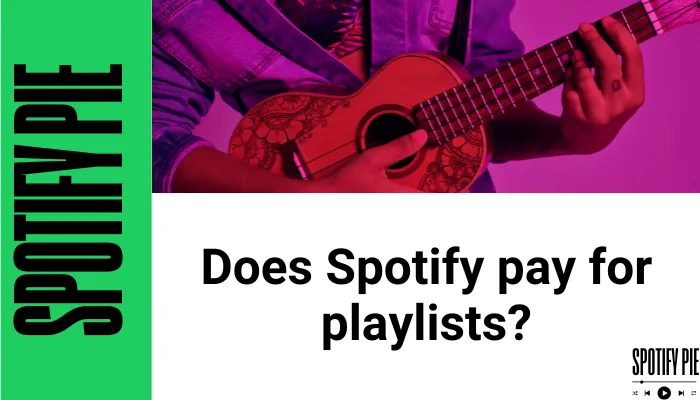Does Spotify Pay for Playlists? Music streaming has changed the way we find and listen to music. No more flipping through radio stations or carefully making mix tapes.
Nowadays, curated playlists dominate supreme providing a personalized and simple way to enjoy music. However, have you ever thought about what goes into these playlists, especially for the leading streaming platform, Spotify?
This article goes deep into the world of Spotify playlists by looking at their mechanics, value for artists and the intricate payment system behind it all.

Definitions and Significance of Playlists
What are Spotify’s playlists? What comes to your mind when you think about a preselected set of songs themed around a subject matter, genre, or mood that can be used in various activities?
These are known as Spotify playlists which allow one to access curated collections of music without having to create his own playlist.
| Significance of Playlists | Description |
|---|---|
| Discovery | Playlists revolutionize the music industry by facilitating discovery. Listeners find new artists and genres they may not have discovered otherwise. |
| Convenience | Playlists save listeners from endless scrolling, akin to old-school DJs curating music. They offer convenience by presenting a curated selection of tracks tailored to various tastes. |
| Personalization | Curated playlists cater to specific moods and activities, such as workout mixes with high energy levels. They offer personalized listening experiences tailored to individual preferences. |
| Artist Exposure | Playlists provide musicians with an opportunity for exposure to a wider audience, helping them gain more fans and expand their fan base. They serve as a platform for artists to showcase their work. |
Unpacking the Playlist Machine
The distinction among various types of Spotify’s playlists is critical in realizing their impacts:
Official Playlists: This entails numerous genres, moods & decades that have been selected by members of Spotify’s internal team; such as “New Music Friday” & “Rap Caviar”.
Algorithmic Playlists: Based on complex algorithms that scrutinize listening habits and suggest related musical content. “Discover Weekly” & “Release Radar” are some examples of this.
User-created Playlists: This is where Spotify’s openness comes into play. With Spotify, anyone can create and share their own playlists, which has created a vibrant community of music fans.
But how do people actually make these lists?
Official Playlists: These are handpicked songs by a team of expert curators at Spotify who consider genre trends, popularity among artists, and data analysis to offer an inclusive experience.
Algorithmic Playlists: As you use Spotify more often, it starts suggesting tracks based on things such as your saved songs, what you have listened to in the past few days, or your listening history. The longer one uses the platform the better the system understands them.
What about playlist algorithms?
- Audio features: such as pace, rhythm, and genre, help determine what songs should be included in each other.
- User data: Your preferences and habits affect these recommendations strongly.
- Popularity: Many times these lists mix established names with up-and-comers so that they feel familiar but exciting at once.
Why Getting Featured Matters?
Artists’ ambitions always lie in appearing on famous Spotify playlists because:
Attracting millions of new listeners to your music by being featured on a high-profile playlist can greatly help build your brand. Think about having a song discovered over “New Music Friday.”
A stronger audience base means greater streams thus more money for artists. Every stream counts so that the song can become a hit! Any artist’s work gets more credibility and approval when it features in one of these playlists.
A lot of artists have had their careers blown out by featuring on Spotify playlists. For example, rapper Lizzo whose hit single “Truth Hurts” went viral after it was included in the “Rap Caviar” playlist.
How Artists Get Paid (or Not Paid) on Spotify?
However, while there is no doubt that this placement has its benefits, the payment structure for artists on Spotify is intricate and often disputed. Here is a breakdown:
- Understanding Spotify’s payment model: Spotify pays rights holders (artists, labels, etc.) from a pool of money based on the total number of streams it has given to any music on its platform. This amount is then shared between them pro-rata meaning that if an artist has been streamed much more than others, they get a larger slice of pie.
- Royalties and streaming revenue distribution: An artist earns minutely per stream which typically amounts to less than a cent. Nevertheless, with millions of streams on popular playlists, those fractions may add up quite nicely.
How Playlists are Shaping the Music Industry?
Music is all about discovery. Whether it was flipping through radio stations before the internet or digging through record stores for extraordinary albums, the joy of finding new artists has remained unchanged. However, the advent of platforms such as Spotify has rapidly changed this trend.
This marked a new period of playlists that are organized for every mood and activity across genres. But behind every endless stream of music lies an intricate ecosystem – one in which an artist’s career can be made or broken by playlist placement.
The Playlist PowerPlay
Playlists have a strong pull on listener preferences. For instance, making it to major Spotify playlists like “New Music Friday” or “Rap Caviar” could expose your work to millions overnight. This industry has created companies that connect artists with curators who actually determine what gets into those powerful selections.
Still, there are ethical concerns about this rush for gold; Payola (paying for airplay), now has its digital equivalent.
Are curators making honest choices based on artistic value or is money affecting their judgment? It might create an uneven playing field, especially between bigger-budgeted major labels and independent artists.
Here’s a breakdown of the impact:
- Major Labels: Their resources allow them to leverage playlist pitching services and potentially secure placement through less-than-transparent means.
- Independent Artists: Often rely on building relationships with curators organically, which takes time and effort. However, with a strong fanbase and strategic use of social media, they can still make waves.
Actionable Tip: Focus on crafting high-quality music with a clear genre identity. This increases the chances of resonating with curators building specific playlists.
Strategies for Playlist Success
So how do artists find their way through these complex channels to be heard? Here are some key strategies:
Building Relationships with Curators: Although there is help from playlist pitching services, greater benefits can come from real connections. Look for curators who are in your genre and talk to them about your music. On the contrary, it is better to engage them in conversations about music more generally.
Optimizing Metadata and Promotional Efforts: Ensure that the genre and mood tags on your music are correct. It helps Spotify algorithms match these tracks with listeners looking for similar vibes. Furthermore, develop a targeted promotional strategy – create a captivating artist profile, share snippets of your music online, and build anticipation around new releases.
Fan Engagement and Social Media Presence: The more engaged your fans are, the higher the likelihood they will save songs or add them to their own playlists. Consequently, this sends positive signals to Spotify’s algorithms. Use social media platforms such as Instagram and TikTok to connect with potential followers; showcase engaging content; and hype up forthcoming projects.
Remember: Consistency is key. Consistently releasing quality work while interacting with fans on a regular basis increases discoverability in the long run.
Navigating the Maze: Challenges and Criticisms
But despite playlists having an undeniable influence; there are other factors to bear in mind:
- The Lack of Diversity: Curators are often sticklers for tradition, which results in all playlists sounding the same. This can make it difficult for lesser-known artists or those experimenting with new genres to gain traction.
- Competition and Oversaturation: It is a tough competition since there are millions of artists who aim at being on the playlist. This can lead to a situation where only a select few “playlist darlings” receive the bulk of the attention.
- Algorithmic Bias and Manipulation: Spotify’s algorithms play an important part in playlist curation. Nevertheless, there are fears that these algorithms might reinforce existing biases within the music industry thereby making it harder for some genres or demographics to break through.
Food for Thought: Can we strive towards having a more balanced playlist scene that recognizes different types of performers and music?
Conclusion
In conclusion, “Does Spotify Pay for Playlists?” Playlists have radically transformed the music world. Nonetheless, there is still plenty of room for improvement and development. Here is a summary:
Playlists exert significant influence over today’s music industry. Ethical issues relating to playlist pitching and payola necessitate ongoing dialogue.
Independent artists can use methods such as building networks, social media interactions, and optimizing metadata in order to increase their chances of securing a place on a playlist. Ongoing challenges include a lack of diversity, competition, and potential algorithmic bias.
The Future: As streaming technology evolves, how will playlists continue to foster vibrant inclusive musical landscapes?
